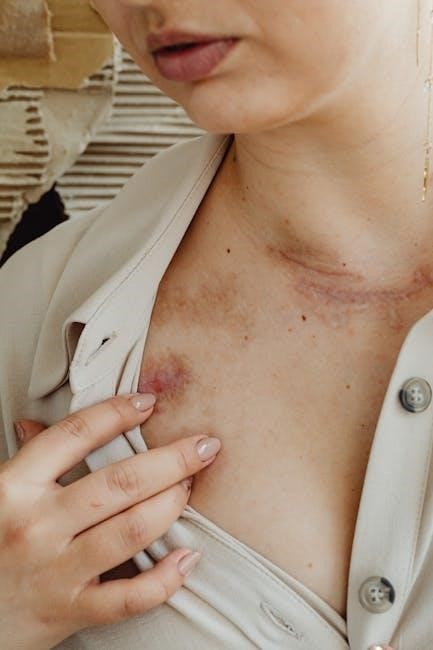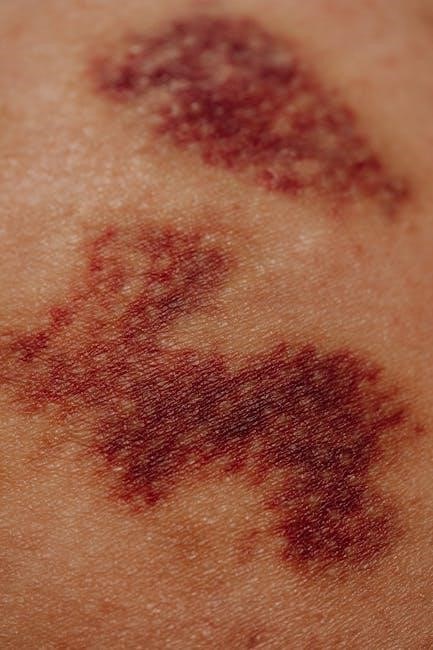Nursing Care Plan: Acute Pain Examples
Nursing care plans prioritize assessments and interventions for acute pain‚ guiding both short- and long-term care goals. Individualized plans are essential‚ addressing factors contributing to each patient’s unique pain experience. Examples help nurses improve care.
Effective pain management is a cornerstone of nursing practice‚ requiring a comprehensive understanding of pain assessment and intervention strategies. Nursing care plans play a vital role in guiding individualized pain management approaches. These plans ensure consistency and coordination in addressing acute and chronic pain‚ ultimately enhancing patient comfort and improving outcomes. Nurses collaborate with healthcare teams‚ integrating pharmacological and non-pharmacological interventions to alleviate suffering.
Importance of Individualized Nursing Care Plans
Individualized nursing care plans are paramount in effective pain management because pain perception varies significantly among individuals. Factors such as underlying conditions‚ emotional state‚ and cultural background influence the pain experience. A tailored care plan considers these nuances‚ allowing nurses to address specific needs and preferences. This personalized approach ensures the selection of appropriate interventions‚ optimizes pain relief‚ and enhances patient satisfaction. Moreover‚ it fosters a collaborative partnership between the nurse and the patient.
Assessment of Acute Pain
A thorough assessment is crucial for effective acute pain management. It involves collecting both subjective‚ what the patient reports‚ and objective data‚ what the nurse observes‚ to understand the pain experience fully.
Subjective and Objective Data Collection
Gathering subjective and objective data forms the foundation of a comprehensive pain assessment. Subjective data includes the patient’s description of their pain‚ such as location‚ intensity‚ and quality. Objective data involves observable signs like vital signs (elevated BP‚ HR‚ RR if patient has a lot of pain)‚ guarding‚ and facial expressions. Combining both types of data provides a holistic understanding of the patient’s pain experience‚ enabling nurses to tailor interventions effectively.
Utilizing Pain Assessment Tools (e.g.‚ OLD CARTS)
Effective pain management relies on consistent and accurate assessment. Pain assessment tools‚ such as OLD CARTS (Onset‚ Location‚ Duration‚ Character‚ Aggravating factors‚ Relieving factors‚ Timing‚ and Severity)‚ provide a structured approach. These tools help nurses gather detailed information about the patient’s pain experience. Regular use of these tools allows for monitoring changes in pain levels and evaluating the effectiveness of interventions‚ ensuring optimal pain control.
Common Nursing Diagnoses Related to Acute Pain
Common nursing diagnoses related to acute pain include: acute pain related to surgical incision‚ acute pain related to inflammation. These guide nursing care to address the underlying causes and symptoms.
Acute Pain related to Surgical Incision
Acute pain related to surgical incision is a frequent diagnosis post-operatively. Interventions include administering analgesics‚ monitoring pain levels‚ and providing comfort measures. The goal is to manage pain effectively‚ facilitating recovery and preventing complications. Assessing the patient’s pain using tools like OLD CARTS is crucial. Patient education regarding pain management strategies is also essential for optimal outcomes.
Acute Pain related to Inflammation
Acute pain related to inflammation arises from tissue injury or infection‚ triggering an inflammatory response. Nursing interventions focus on reducing inflammation and alleviating pain. Administering anti-inflammatory medications‚ applying ice or heat‚ and promoting rest are key strategies. Assessing pain characteristics and monitoring for signs of infection are also crucial. Patient education about managing inflammation and recognizing complications ensures optimal outcomes.

Goal Setting for Pain Management
Effective pain management requires establishing clear‚ measurable goals. These goals should be patient-centered‚ focusing on improved comfort and function. Short-term goals address immediate pain relief‚ while long-term goals aim for sustained pain control and enhanced quality of life.
Short-Term and Long-Term Goals
Short-term goals in pain management focus on immediate relief‚ aiming to reduce the patient’s pain level within hours or days. Examples include achieving a specific pain score reduction or improved comfort during activities. Long-term goals address sustained pain control‚ improved function‚ and enhanced quality of life over weeks or months‚ such as returning to work or engaging in hobbies. Effective planning incorporates both.
Patient-Centered and Measurable Objectives
Patient-centered objectives prioritize the individual’s experience and preferences in pain management. Measurable objectives provide concrete targets for evaluating the plan’s effectiveness. For instance‚ “Patient will report a pain level of 3/10 or less within 4 hours after medication” combines the patient’s subjective experience with a quantifiable measure. Objectives also include tolerance and increased movement.

Nursing Interventions for Acute Pain
Nursing interventions for acute pain involve pharmacological approaches like analgesics. Non-pharmacological methods‚ such as comfort measures and distraction techniques‚ are also employed. These interventions aim to reduce pain and enhance patient comfort.
Pharmacological Interventions (Analgesics)
Administering analgesics is a crucial pharmacological intervention for managing acute pain. Nurses must understand different types of pain medications‚ including opioids and non-opioids‚ and their respective side effects. Proper dosage and timing are essential for effective pain relief. Regularly assess the patient’s pain level to adjust medication as needed‚ ensuring optimal comfort. Monitor vital signs and watch for any adverse reactions to the medication.
Non-Pharmacological Interventions (Comfort Measures‚ Distraction Techniques)
Complementing pharmacological interventions‚ non-pharmacological approaches significantly aid in acute pain management. Comfort measures include proper positioning‚ massage‚ and thermal applications (heat or cold). Distraction techniques‚ like music‚ deep breathing exercises‚ or guided imagery‚ can divert attention from the pain. Creating a calm and restful environment is also beneficial. Employing these strategies enhances patient comfort and reduces reliance on medication‚ improving overall well-being and promoting relaxation during recovery.

Evaluation and Revision of the Care Plan
Regularly monitor pain levels and responses to interventions. Adjust the plan based on patient feedback and reassessment. If pain isn’t controlled‚ revise strategies‚ considering alternative analgesics or consulting specialists for optimal management.
Regular Monitoring of Pain Levels
Consistent assessment of pain is vital for effective management. Nurses should regularly evaluate the patient’s pain intensity using standardized scales‚ documenting both subjective reports and objective signs such as facial expressions or body language. Frequency of monitoring depends on pain severity‚ interventions implemented‚ and the patient’s condition. Monitoring helps determine the effectiveness of interventions and guides adjustments to the care plan‚ ensuring optimal pain relief and improved patient comfort throughout the care continuum. The monitoring process should include documentation of pain characteristics (OLD CARTS).
Adjustments Based on Patient Response
The care plan must remain flexible‚ adapting to the patient’s evolving response to interventions. If pain control is inadequate‚ consider modifying analgesic dosages‚ routes‚ or frequencies‚ or adding adjuvant medications. Non-pharmacological approaches may also require adjustments‚ such as altering positioning‚ distraction techniques‚ or environmental modifications. Consultation with pain management specialists is warranted for complex or refractory pain. Document all changes‚ including the rationale and patient’s subsequent response. Regular reassessment following adjustments is crucial to ensure optimal pain management.
Examples of Acute Pain Nursing Care Plans (PDF)
Explore comprehensive acute pain nursing care plan examples in PDF format. These plans offer practical guidance for managing diverse pain scenarios‚ enhancing patient comfort‚ and improving outcomes through tailored interventions.
Post-Operative Pain Management Plan
Post-operative pain management plans are crucial for patients recovering from surgery. These plans involve assessing pain levels‚ administering analgesics‚ and employing non-pharmacological methods. Regular monitoring and adjustments are vital for effective pain control. Nurses play a key role in implementing these plans‚ ensuring patient comfort and promoting healing. Patient education on pain management strategies is also integral to successful recovery.
Pain Management in Chronic Conditions
Managing pain in chronic conditions requires a comprehensive approach‚ often involving a combination of pharmacological and non-pharmacological interventions. Nursing care plans should address the patient’s physical‚ psychological‚ and social needs. Regular assessment‚ patient education‚ and collaboration with specialists are essential. The goal is to improve the patient’s quality of life by reducing pain and enhancing their ability to function effectively. Individualized strategies are crucial for successful chronic pain management.
Collaboration with the Healthcare Team
Effective pain management requires teamwork. Nurses‚ physicians‚ and specialists must communicate. Collaboration ensures consistent‚ coordinated care‚ optimizing patient outcomes. Teamwork is key for moderate‚ acute‚ and chronic pain.
Importance of Teamwork for Optimal Pain Management
Optimal pain management necessitates a collaborative approach among healthcare professionals. Nurses‚ physicians‚ pharmacists‚ and pain specialists each contribute unique expertise‚ ensuring a comprehensive understanding of the patient’s condition. Effective communication and shared decision-making are crucial for developing and implementing individualized pain management strategies. Regular team meetings‚ clear documentation‚ and mutual respect foster a supportive environment‚ ultimately leading to improved patient outcomes and satisfaction in pain control.
Consultation with Pain Management Specialists
When pain proves challenging to manage‚ consulting with pain management specialists becomes paramount. These specialists possess advanced knowledge and skills in assessing and treating complex pain conditions. They can offer alternative pharmacological and non-pharmacological interventions‚ conduct specialized procedures‚ and provide guidance on managing chronic pain. Collaboration with pain management specialists ensures that patients receive the most appropriate and effective treatment strategies‚ leading to enhanced pain relief and improved quality of life. Their expertise complements the nursing care plan.

Patient Education and Discharge Planning
Effective education empowers patients to manage pain at home. Discharge plans must include comfort measures‚ medication schedules‚ and strategies for pain control. Clear instructions enhance adherence and improve long-term outcomes for the patient.
Teaching Comfort Measures and Pain Management Strategies
Educating patients on comfort measures and pain management is crucial for their recovery. This includes teaching relaxation techniques‚ proper body mechanics‚ and the effective use of analgesics. Patients should understand the importance of reporting uncontrolled pain promptly. Moreover‚ nurses should discuss non-pharmacological options like heat or cold therapy‚ distraction techniques‚ and the benefits of maintaining a comfortable environment to promote healing and reduce pain perception. Empowering patients with knowledge promotes active participation in their care.
Creating a Discharge Plan for Pain Control
A comprehensive discharge plan is essential for continued pain control at home; This plan should include detailed instructions on medication schedules‚ potential side effects‚ and when to seek medical attention. The nurse should provide information on non-pharmacological strategies‚ like exercise or physical therapy‚ and community resources for ongoing support. The plan needs to address potential complications‚ ensuring the patient knows how to manage pain flares or other related issues after discharge‚ contributing to a smoother transition.
Consistent pain management is crucial for improving patient outcomes and quality of life. Utilizing individualized nursing care plans‚ healthcare teams can proactively address acute pain and prevent it from becoming chronic. Regular assessment‚ tailored interventions‚ and patient education are essential components of an effective pain management strategy. By collaborating and continuously monitoring patient responses‚ nurses play a pivotal role in ensuring consistent and optimal pain relief‚ enhancing overall well-being and satisfaction.




